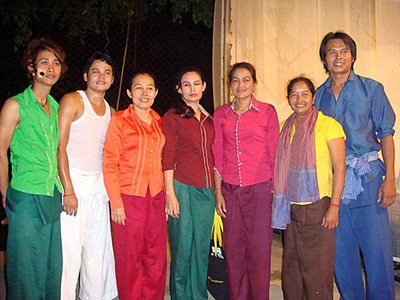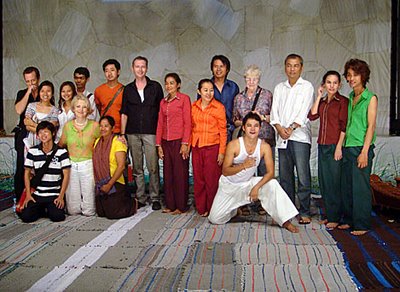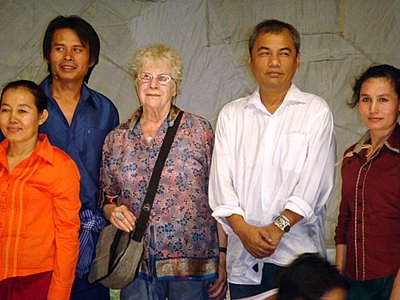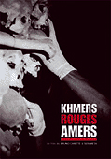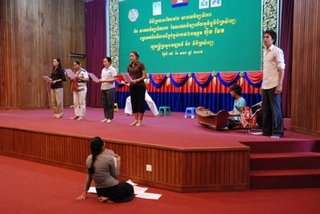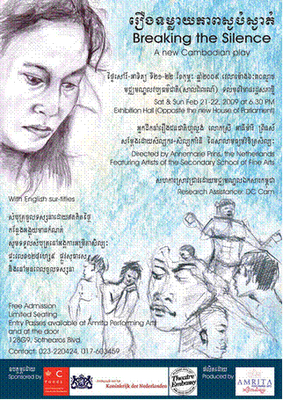Under a full moon
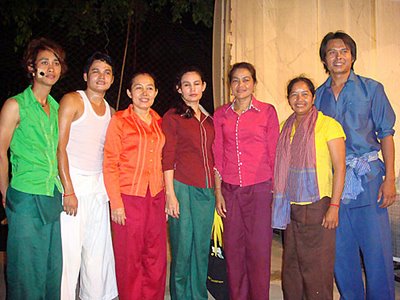 The on-stage cast of Breaking the Silence; LtoR: Sakona, Tonh, Sovanna, Sotheary, Sokly, Sina, Vutha
The on-stage cast of Breaking the Silence; LtoR: Sakona, Tonh, Sovanna, Sotheary, Sokly, Sina, VuthaA drama of closure for victims and perpetrators of the Khmer Rouge - by Sally McGrane (International Herald Tribune)
In Cambodia's Takeo Province, night fell on a field across from the village pagoda. Women cooked crispy cakes over open fires to sell to the crowd. By the time the lights came on, several hundred villagers had assembled in front of a portable stage. The Cambodian actors, dressed in street clothes, began speaking in Khmer. "So many stories. We have to tell our stories," said one. Another said, "How did it happen that Khmer killed Khmer?" 'You must try," said a third, "To help us think this through." The audience in this heavily former Khmer Rouge area watched with attention as "Breaking the Silence," the Phnom Penh-based Amrita Performing Arts' new play, proceeded on Sunday night. Written by a Dutch director, Annemarie Prins, "Breaking the Silence" is based on oral testimony from Khmer Rouge members and victims who had taken part in interviews at the Documentation Center of Cambodia. The play tells the stories of seven perpetrators and victims in a series of short vignettes.
But it is not just a play. Performing concurrently with the Khmer Rouge tribunals, "Breaking the Silence" is an appeal to Cambodians on both sides of the divide to speak up about what happened to them. "We want this to be in the service of the community," the Amrita's program director, Suon Bun Rith — whose grandmother lives in Takeo, just down the unpaved road from the performance space — said on a recent weekend. To this end, after each show, Suon or an emissary invited audience members to come forward and tell their stories. After the performance Sunday night, a man took the microphone. "Those who killed should come and see this show," he said, going on to say that he lived near a man who had killed several members of his family. He cited a scene in the play in which a former Khmer Rouge nurse apologizes for not helping a woman's dying father, explaining that she was trapped by circumstances. "Sometimes I try to talk to this man who killed my family," said the speaker. "But he just turns away." The play is very sympathetic to the perpetrators whose stories it tells, portraying them as victims in their own right. "We don't blame anyone," said Suon. "We want the community to start a dialogue."
The play premiered in Phnom Penh in late February, and then toured the provinces for eight performances, the last of which was Wednesday. This is unusual in a country in which nearly all cultural events take place in the capital or in Siem Reap (and was the cause of some pre-performance confusion for a food vendor in Takeo, who asked Suon if this was going to be a magic show put on by traveling medicine salesmen). The fact that it reaches isolated areas is part of what makes the play so powerful, according to Youk Chhang, who runs the Documentation Center of Cambodia and collaborated with Prins in the early stages of the project. "People talk about the tribunals, and of course that's good for the victims," he said. "But these people can't go to the trials." He was referring to the United Nations-backed Khmer Rouge genocide tribunal that began Feb. 17th in Phnom Penh. "This is something for them in the village. This is their stage and their court."
Chhang, who recently proposed to the minister of education that the play be included in school curriculums, dismissed the idea that a Western director might impose a Western understanding of trauma on the actors and audience. "Genocide is a crime against humanity," he said. Prins "isn't Dutch, she's human." He reconsidered, then said, "The title — 'Breaking the Silence' — that's foreign. But we don't call it that, in Khmer." While Amrita translates the title more or less directly, Chhang said that only a handful of educated city dwellers refer to it that way. "The villagers call it 'Khmer Rouge Stories' or 'Pol Pot Stories,'" he wrote in an e-mail message. For Chhang, the play holds up a mirror for the audience — something, he said, that was important for the victims' process of healing from the trauma they have experienced. He also cited the play's emphasis on Buddhist philosophies of forgiveness. Then he added, "I think of myself as a strong person, a bone collector. A relentless genocide investigator. But the first time I saw this, I cried."
The four main actresses were all victims of the Khmer Rouge regime. Morm Sokly, in her 40s, plays a 7-year-old girl in one vignette who, famished, steals the family's rice. "My own experience gives me a depth of understanding for what we play on the stage," she said. "The girl who steals the rice — I have that guilt in myself." The younger members of the production said that they learned from the play, as well. "Before, as a Cambodian, I knew my mom and her family had had very sad experiences and lost family members," said Chey Chankeytha, 24, a classically trained dancer who choreographed the show. "But I had never heard from the people who worked in the killing fields. From the play, you see how it felt to be a Pol Pot child soldier. We should know both sides."
The play's current run ended this week under a full moon in a field across from a rice paddy in Kandal Province with a small but rapt core audience (several middle aged women had returned for a second night in a row). Barring funding problems, the performance will resume in November after the rainy season with another eight shows in the Battambang and Siem Reap regions. Given the reactions of those who choose to speak after the performances, "Breaking the Silence" seems to hit a nerve. After the Saturday night performance in Takeo ended, a gray-haired woman took the microphone. Crying softly, she said, "This was my story I saw on the stage. The kids might not believe it, but it's true."
Labels: Breaking the Silence
